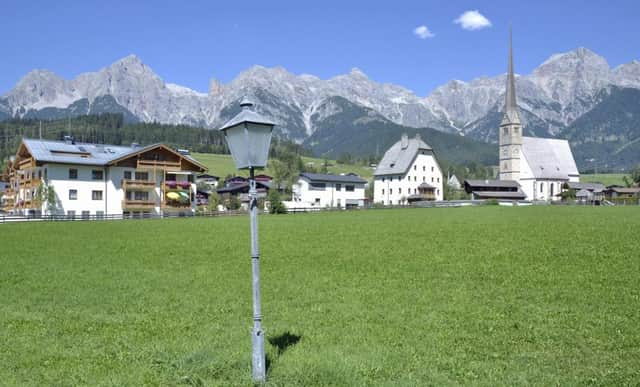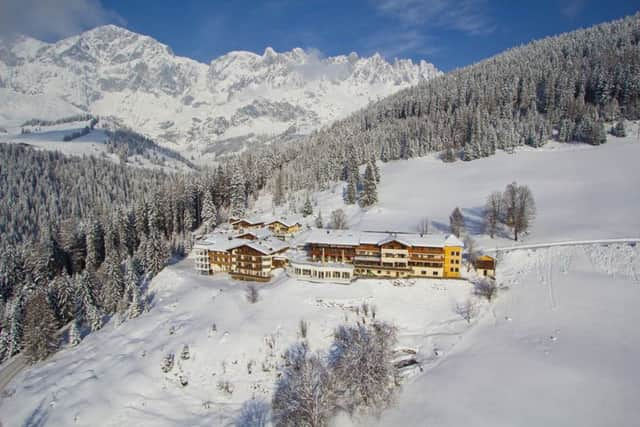Travel: The hills are alive again at Salzburg


TECHNOLOGY has made skiing easier. In a basement room at the Hotel Bergheimat, Helmut Plenk picked out a pair of Atomic carving skis from the rental rack. Stood on end, they came up to my nose. The last time I had skied in his presence I’d been provided with monsters that reached to the end of my upstretched arm. Turning on them was like manoeuvring an oil tanker. Today’s carvers turn with little more than a twitch.
The Bergheimat sits on the mountainside above Mühlbach am Hochkönig in Austria’s Salzburg region. It’s not the most conveniently located of ski hotels, as the slopes are a bus ride away across the valley, but it’s a lovely place to stay, with splendid views from its large, comfortable bedrooms, a spa and an indoor pool.
Advertisement
Hide AdAdvertisement
Hide AdWhile his daughter and son-in-law run the hotel, Herr Plenk is its patriarch. When I first encountered him he was head of the ski school and I was still an unaccomplished beginner, barely off the baby slopes.


Mühlbach was an unassuming village, struggling to replace the income from a defunct copper mine with the new tourist gold. Skiing was just taking off in the UK and, to the locals, package holidaymakers were still a novelty. In the evenings, ski instructors and the owner of the village ski shop would join Brits for drinks.
There was one, single-seat chairlift and a T-bar which stopped halfway up because the operator couldn’t agree a deal with the farmer who owned the top field. For variety there was a Land Rover, which ran past the Bergheimat to the Arthurhaus, an inn beneath the great mountain parapet of the Mandelwand, where there were two or three lifts. That, apart from one other isolated T-bar, was that.
Après ski after a day at the Arthurhaus was a half litre of Jägertee (hunter’s tea) in a steamy, crowded little hut where the Land Rover picked us up. The Jägertee was said to comprise rum, schnapps and tea in equal thirds. If you waved a cigarette lighter flame across the top, the fumes flared. After that, full of alcoholic bravado, some would ski down across the meadows in the dark, watching for barbed wire just below the snow’s crust, chased by the odd farm dog.
Local pessimists said Mühlbach would never amount to a real ski resort. They were to be proved dramatically wrong. Today it’s part of a huge network of 270 lifts and, or so it claims, 760km of piste. It is marketed as Ski Amadé – after Salzburg’s favourite son, WA Mozart. The area embraces a clutch of small resorts including Maria Alm, Dienten, Alpendorf. Wagrain and Filzmoos. Skiing between them is a pleasant experience.
This terrain is perhaps best suited to competent intermediates or those who like a workout without having to screw up their courage. There are plenty of wide pistes that are steep enough to demand concentration without testing the nerve. And other than at weekends and on public holidays, when day skiers from the city of Salzburg turn out in droves, they are uncrowded.
The area is not without imperfections. Its constituent parts are not all connected by lifts, and moderate altitude means that in late season, though piste preparation is impressive, it can be prone to morning ice and afternoon slush. When my wife and I visited in mid-March, skiing some of the lowest runs became hot, hard labour. But slush has its compensations. There can be few, if any ski areas with as many inviting refreshment stops on the slopes. Thus the temptation to break off for a cooling drink in the sunshine at an outside table was rarely far from our minds.
We started this trip at another excellent hotel, the Alpendorf, above the village of the same name. Its owners have a neighbouring farm, centuries old, with a small herd of cattle. You can ski almost to the hotel door but the easy way to reach the slopes is to catch the hotel’s free shuttle, which takes you to the main access lift in a few minutes. From there you can ski to Wagrain and cross to Flachau via a cable car slung across the valley between.
Advertisement
Hide AdAdvertisement
Hide AdI came across a wonderful photograph of a woman being helped from the first ski lift to be built in Salzburg. She appeared to be dressed in normal, daytime clothing. The attendant assisting her wore something like a railway ticket collector’s uniform. The Alpendorf and the Bergheimat have been in their respective families for decades. What a cataract of change they have seen. Pistes have proliferated, uncomfortable old lifts that whacked you on the calves have given way to high speed lifts that slow down as you board, you can access the internet on the slopes and the advent of carving skis means that skiing with your knees and ankles pressed together is no longer the elusive Holy Grail.
This winter there’s even an app that enables you to receive information on the lens of specially adapted goggles. Amid all that, however, there has been one constant: the warmth of Austrian hospitality.
• Jet2 (Jet2.com) flies to Salzburg from Edinburgh, Thomson Airways (Thomson.co.uk/flight) flies there from Glasgow. You could rent a car, though the distance between airport and resorts is so short it’s worth comparing taxi prices. Outside public holidays, half board at the Bergheimat starts at €98 or €113 per person per night, depending on dates. The Alpenhof (alpenhof.co.at) (bergheimat.com) offers 7 night half board deals, including a ski pass, from €916.50 per person.